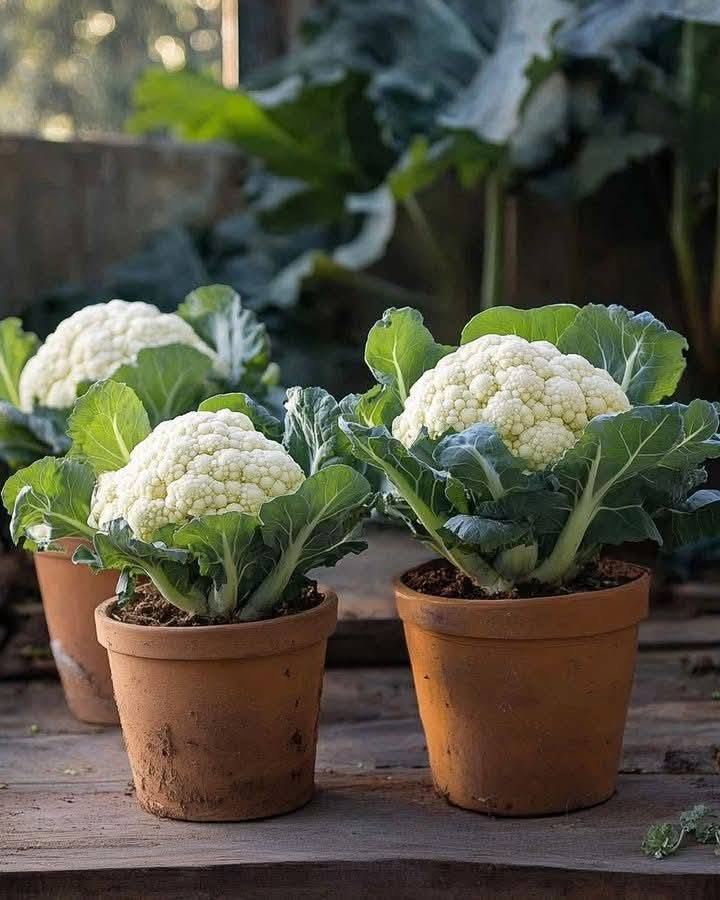ADVERTISEMENT
“`html
Grow Gigantic Cauliflower in Pots: A Gardener’s Delight
Dreaming of fresh, homegrown cauliflower without a sprawling garden? Let’s make that dream a reality! Growing cauliflower in pots is surprisingly easy and rewarding, perfect for balconies, patios, or even sunny windowsills. This guide will walk you through every step, from choosing the perfect variety to harvesting your prize-winning heads. Get ready to experience the joy of homegrown goodness!
1. Choosing the Best Cauliflower Variety for Pots
Not all cauliflower varieties thrive in containers. For the best results, opt for compact or dwarf varieties that won’t outgrow their pots. Here are some excellent choices:
- ‘Snowball’ – A classic, fast-growing variety with tight, white heads. Perfect for beginners!
- ‘Amazing’ – Produces large, dense heads and is heat-tolerant, ideal for warmer climates.
- ‘Mini White’ – Ideal for small pots, offering petite but flavorful heads.
Remember to select a variety suited to your climate and growing season for optimal growth.
2. Selecting the Right Pot & Soil
Pot Requirements:
- Size: At least 12-18 inches deep and wide (cauliflower has deep roots!).
- Material: Plastic, ceramic, or fabric pots all work well. Make sure it’s sturdy enough for the plant’s growth.
- Drainage: Multiple drainage holes are essential to prevent waterlogging and root rot.
Soil Mix:
- Use a rich, well-draining potting mix amended with compost or aged manure. Think of it as a delicious cauliflower buffet!
- Aim for a pH between 6.0-7.0 (slightly acidic to neutral).
- Add perlite or vermiculite to further improve drainage.
3. Planting Cauliflower: Seeds vs. Transplants
Starting from Seeds:
- Sow seeds ¼ to ½ inch deep, spacing them 3-4 inches apart. Give those little guys room to grow!
- Keep the soil consistently moist but not soggy until germination (7-14 days). Think Goldilocks and the Three Bears – not too wet, not too dry, just right!
- Once seedlings have 2-3 true leaves, thin to one strong plant per pot.
Using Transplants:
- Buy healthy, disease-free seedlings from a nursery. Choose sturdy plants with vibrant green leaves.
- Plant at the same depth as in their original container.
- Water thoroughly after planting.
4. Sunlight & Temperature Requirements
- Sunlight: 6-8 hours of direct sunlight daily (provide afternoon shade in hot climates). Cauliflower loves a good sunbath, but too much can be a bit too much!
- Temperature: The ideal range is 60-70°F (15-21°C).
- Too hot? Heads may become loose or “button-like.”
- Too cold? Growth slows down significantly.
Tip: Use shade cloth if temperatures exceed 75°F (24°C).
5. Watering & Fertilizing for Maximum Growth
Watering:
- Keep the soil consistently moist; cauliflower hates drought! Regular watering is key.
- Water deeply 2-3 times per week, ensuring good drainage. Let the soil dry slightly between waterings to avoid waterloggin.
- Avoid overhead watering to prevent fungal diseases. Water at the base of the plant.
Fertilizing:
- Use a balanced fertilizer (10-10-10) every 4-6 weeks.
- Alternatively, feed with compost tea or fish emulsion for organic growth.
- Too much nitrogen? You’ll get big leaves but small heads!
6. Blanching for Perfect White Heads
Cauliflower heads turn yellow or green if exposed to too much sun. To keep them pure white:
- When the head is 2-3 inches wide, gently tie the outer leaves over it with twine. This will protect the head from the sun.
- Check every few days to ensure no moisture buildup (which can cause rot).
Self-blanching varieties (like ‘Snowball’) may not need this step.
7. Pest & Disease Management
Common Pests:
- Aphids, cabbage worms, slugs – Use neem oil or handpick them.
- Cabbage loopers – Apply Bt (Bacillus thuringiensis).
Diseases to Watch For:
- Clubroot – Ensure good drainage.
- Downy mildew – Avoid wetting leaves; use copper fungicide if needed.
Prevention: Rotate crops and keep pots clean.
8. Harvesting Your Giant Cauliflower
- Timing: Heads are ready 70-100 days after planting.
- Signs of Readiness:
- Head is firm, compact, and 6-8 inches wide.
- If it starts to separate or discolor, harvest immediately!
- How to Harvest: Use a sharp knife to cut the head, leaving a few leaves attached.
9. Common Mistakes to Avoid
❌ Too small of a pot → Stunted growth.
❌ Inconsistent watering → Cracked or bitter heads.
❌ Overcrowding → Poor air circulation = disease risk.
❌ Ignoring pests → Can ruin your crop quickly!
10. Enjoy Your Homegrown Cauliflower!
Now that you’ve grown a huge, delicious cauliflower, try:
- Roasting with olive oil & spices.
- Mashing as a low-carb alternative to potatoes.
- Making cauliflower rice or pizza crust.
With these steps, you’ll maximize your cauliflower’s size and flavor—right from your pot! 🌱🥦
Happy Gardening!
“`
